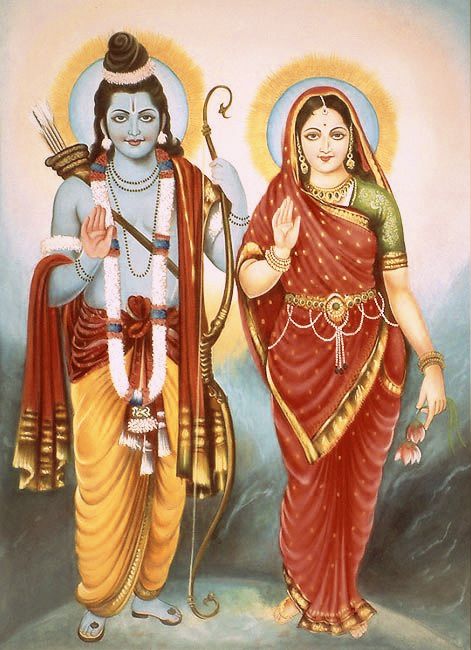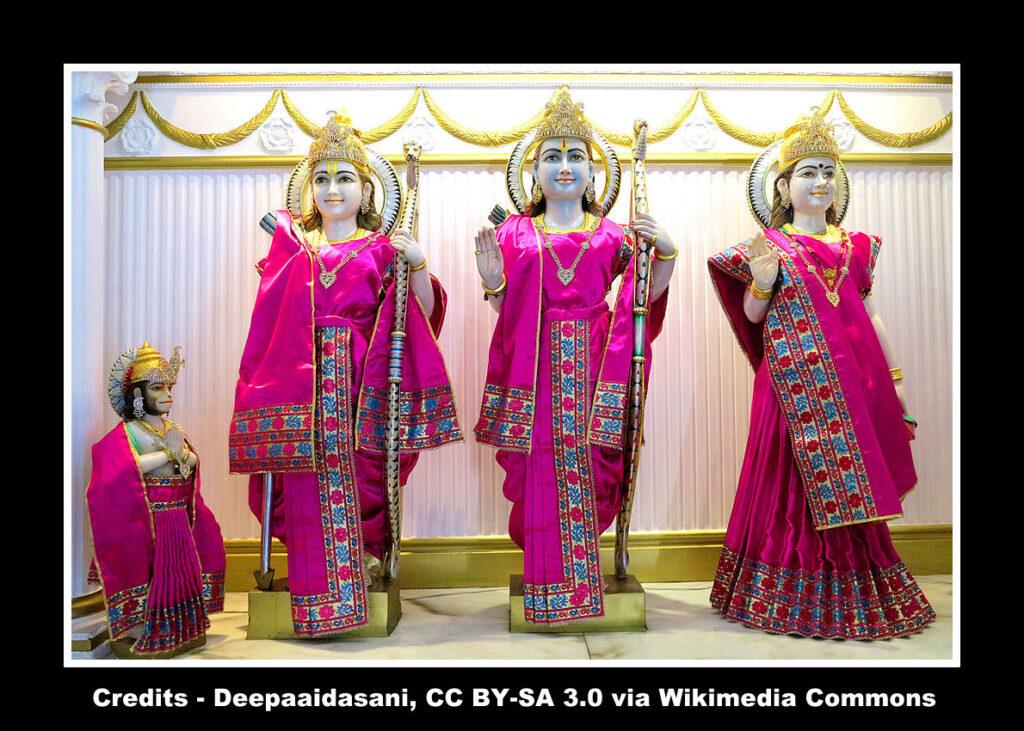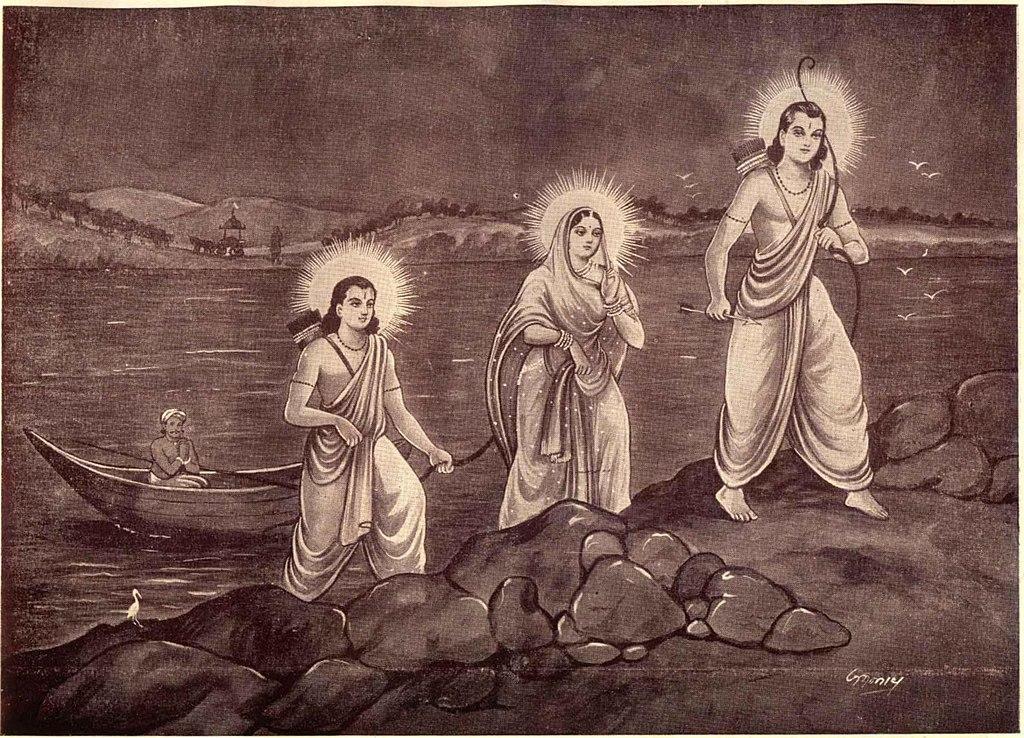
In the annals of ancient Hindu scriptures, Sita Devi stands as a figure of unparalleled grace, virtue, and unwavering devotion. Revered as the epitome of beauty, purity and fidelity, Sita Devi’s extraordinary tale unfolds within the timeless epic Ramayana. She emerges as the beloved daughter of King Janaka, a revered personality among the twelve great spiritual authorities, known as mahajanas. Such lineage of divine ancestry led to one of her revered names, Janaki. Valmiki’s Ramayana beautifully narrates the origin of Sita Devi, tracing her mystical beginnings to an enchanting episode. According to this ancient epic, Sita Devi was discovered in a furrow within a plowed field, which has now transformed into the city of Sitamarhi, nestled within the historic Mithila region of present-day Bihar. This extraordinary origin story weaves a profound connection between Sita Devi and Bhumi Devi, the goddess Earth herself, leading to her being regarded as the cherished daughter of the divine mother. As we delve into the life and virtues of Sita Devi, we unearth an extraordinary journey of resilience, compassion, and unyielding faith. Her tale not only encapsulates the essence of ideal womanhood but also offers profound spiritual insights and timeless teachings. From her unparalleled devotion to Lord Rama, her noble consort, to her unwavering strength during times of adversity, Sita Devi’s legacy continues to inspire countless souls, transcending the boundaries of time and space.
Birth of Sita Devi
Within the timeless epic Ramayana, the captivating tale of Sita Devi unfolds, depicting a narrative filled with divine blessings and extraordinary circumstances. Born as the cherished daughter of Janaka Maharaja, her arrival into the world defied conventional expectations, imbuing her existence with an air of mystique and spiritual significance. Janaka Maharaja, despite his noble stature, was childless, prompting the wise Brahmins to propose a unique solution to his yearning for progeny. Advised to perform a sacred hola-yajna, a fire sacrifice ritual, Janaka embarked upon the prescribed path, seeking the blessings that would grant him the joy of parenthood. Following the guidance of the Brahmins, Janaka grasped a plough in his hands and traced a symbolic line around his palace. The act represented his unwavering dedication and commitment to fulfill his deepest desire. To his astonishment, as the plough moved forward, it encountered an unexpected obstacle, stubbornly resisting any further progress.
 Recognizing that an extraordinary hindrance lay concealed beneath the surface, a collective realization emerged. The gathered onlookers, including the sagacious Brahmins, embarked upon a determined excavation, determined to unveil the enigma that lay before them. Their efforts were rewarded when a concealed box was unearthed, harboring an extraordinary revelation within. Within the confines of the box, an enchanting sight met their eyes—a baby girl radiating a divine beauty reminiscent of the goddess Lakshmi herself. This celestial child, resembling the epitome of grace and virtue, was christened Janaki, signifying her status as the beloved daughter of Janaka. Embracing her with boundless love, Janaka Maharaja raised her within the opulence of his palace. The auspicious plowing episode bestowed upon Janaka the epithet “Siradhvaja,” a tribute to the extraordinary circumstances surrounding Sita Devi’s appearance. The title “Siradhvaja” symbolized the moment when the front of his plough’s furrow (sira) uncovered the divine presence of Sitadevi, an exquisite daughter born to Janaka.
Recognizing that an extraordinary hindrance lay concealed beneath the surface, a collective realization emerged. The gathered onlookers, including the sagacious Brahmins, embarked upon a determined excavation, determined to unveil the enigma that lay before them. Their efforts were rewarded when a concealed box was unearthed, harboring an extraordinary revelation within. Within the confines of the box, an enchanting sight met their eyes—a baby girl radiating a divine beauty reminiscent of the goddess Lakshmi herself. This celestial child, resembling the epitome of grace and virtue, was christened Janaki, signifying her status as the beloved daughter of Janaka. Embracing her with boundless love, Janaka Maharaja raised her within the opulence of his palace. The auspicious plowing episode bestowed upon Janaka the epithet “Siradhvaja,” a tribute to the extraordinary circumstances surrounding Sita Devi’s appearance. The title “Siradhvaja” symbolized the moment when the front of his plough’s furrow (sira) uncovered the divine presence of Sitadevi, an exquisite daughter born to Janaka.
Marriage of Sita and Rama
King Janaka owned a magnificent bow whose strength was inestimable. The bow was originally owned by Lord Shiva and it could not be bent even by the demigods, what to speak of humans. Janaka Maharaja had declared that any person who could bend the bow would win the hand of his daughter Sita. Sita was a veritable jewel among women and was born of mother earth herself. Visvamitra Muni suggested that Rama and Lakshmana, who were hunting demons with him at that time, leave for Mithila at that very moment. Sage Visvamitra, Rama, and Lakshmana received a warm welcome at Mithila. King Janaka personally greeted his guests accompanied by priests and counselors. The following morning King Janaka narrated the history of the bow. In the former ages, the concerned bow belonged to Lord Shiva. Shive once became angry with the demigods when they had denied him a share of the sacrificial offerings made by the sages. Shiva threatened the demigods and challenged them to fight. The demigods then came back to their senses and began worshiping Lord Shiva. Being pleased with the demigods, Shiva gifted them that bow. The famous bow was then given by the demigods to Janaka’s ancestor, Devarata after he had fought in a battle against the demons. It had since been kept in the king’s family, being worshiped as if it were Shiva himself. Many proud kings have since tried and failed to string the mighty bow, with a desire to win Sita’s hand in marriage.
 Sita stood on the balcony of the hall and felt a natural attraction toward Rama. Until then, She had never been interested in any of Her suitors as they were arrogant and overly proud. She was deeply religious and always prayed that Vishnu might become Her husband. She wondered whether Rama was Vishnu Himself. She hoped that Rama could string the bow and win Her hand. Three hundred powerfully built men dragged the chest containing the bow to the center of the hall. As the lid was opened, the brilliant bow, which was constructed with pure horn and that depicted pastimes of Gods in gold and silver, was displayed. The bow was studded with diamonds and other gems. Rama bowed before the bow in respect, and after taking permission from Visvamitra, seized the bow by its middle and raised it high above His head. It was an inconceivable feat and the entire hall stood in astonishment. Placing one end of the colossal bow on the ground, Rama strung the other end and pulled the string. The bow bent into a semi-circle. All of a sudden the bow broke, and a sound of thunder reverberated around the hall, rendering everyone senseless for a few moments. Everyone including Janaka Maharaja was amazed. Till now no other King was able to move the bow even slightly till now. However, Rama held it like it was a piece of bamboo. King Janaka was very happy to hand over Sita, his daughter, to Rama in marriage.
Sita stood on the balcony of the hall and felt a natural attraction toward Rama. Until then, She had never been interested in any of Her suitors as they were arrogant and overly proud. She was deeply religious and always prayed that Vishnu might become Her husband. She wondered whether Rama was Vishnu Himself. She hoped that Rama could string the bow and win Her hand. Three hundred powerfully built men dragged the chest containing the bow to the center of the hall. As the lid was opened, the brilliant bow, which was constructed with pure horn and that depicted pastimes of Gods in gold and silver, was displayed. The bow was studded with diamonds and other gems. Rama bowed before the bow in respect, and after taking permission from Visvamitra, seized the bow by its middle and raised it high above His head. It was an inconceivable feat and the entire hall stood in astonishment. Placing one end of the colossal bow on the ground, Rama strung the other end and pulled the string. The bow bent into a semi-circle. All of a sudden the bow broke, and a sound of thunder reverberated around the hall, rendering everyone senseless for a few moments. Everyone including Janaka Maharaja was amazed. Till now no other King was able to move the bow even slightly till now. However, Rama held it like it was a piece of bamboo. King Janaka was very happy to hand over Sita, his daughter, to Rama in marriage.
Sita came down from the balcony and stood with a garland of golden flowers in Her hands. She appeared mesmerizing in a deep maroon silk saree. Her neck was adorned with a necklace of pearls. As she walked, Her golden anklets tinkled and Her diamond earrings swung to and fro. As Her eyes met with Rama, both felt their hearts moved by love. At that moment their union was forged. Sita garlanded Rama, indicating Her acceptance of Him as husband. She blushed and kept Her eyes down. Messengers were dispatched to Ayodhya. King Dasaratha was overwhelmed with joy to learn that Rama and Lakshmana had conquered the demons and were doing well. He felt delighted to learn that Rama had now also won the beautiful Sita for His bride. Reaching Mithila, Dasaratha and Janaka Maharaja embraced each other. King Janaka shared the prophecy that he had heard from Narada Muni. Narada had previously informed him that Sita was Vishnu’s eternal consort and that one day the Supreme Lord would become Her husband in this world. It is for this reason that Janaka Maharaja had devised a test that would only be possible for Vishnu to pass.
Sita’s exile – Life in the Forest
Sita Devi’s life in the forest was filled with both challenges and moments of solace. After being exiled along with Lord Rama and Lakshmana, they were joined by the citizens of Ayodhya who refused to abandon them. Understanding their compassion, Rama, Lakshmana, and Sita quietly left while the people were asleep to spare them further suffering. They sought refuge in the Ushinara province ruled by Rama’s friend, Guha. Despite Guha’s offerings, Rama, adhering to his ascetic vow, declined them. Guha and Lakshmana stood guard as Rama and Sita slept on a bed of leaves. The next day, they bid farewell to Guha and crossed the river, entering the dense forests.

Sita Devi exemplified extraordinary resilience and unwavering devotion during her challenging life in the forest, steadfastly standing by her beloved husband, Lord Rama. Despite being born into royalty, she fearlessly embraced the hardships that came with their exile. Leaving behind the comforts of Ayodhya, Sita willingly ventured into the dense forests alongside Rama and Lakshmana. Throughout their journey, Sita displayed remarkable strength and endurance. She gracefully adapted to the austere lifestyle, finding solace amidst nature’s beauty. Sleeping on beds of leaves and residing in a humble cottage, she never wavered in her dedication to Rama. Despite the trials they encountered, Sita remained a pillar of support, offering love, encouragement, and unwavering faith to her husband. In the forest, Sita encountered various challenges, including the wicked demoness Surpanakha and the subsequent battles with the demon army. Despite the dangers, Sita stood alongside Rama, showing immense courage and resilience. Her unwavering loyalty and selflessness served as a guiding light for Rama and Lakshmana, inspiring them to persevere.
Sita’s Agni Pariksha
Sita Devi, the epitome of virtue and exalted qualities, demonstrated immense strength and unwavering loyalty throughout the trials she endured. Despite being held captive by Ravana for a year, her heart remained steadfastly devoted to Lord Rama. When Hanuman informed her of Rama’s victory, Sita’s face radiated with joy like the moon. However, her elation turned to shock upon hearing Rama’s apparent hesitation to accept her due to the doubts of the citizens.
In the face of this injustice, Sita remained resolute and determined to uphold her chastity and honor. She chose to prove her purity by entering a blazing pyre, invoking the fire god Agni to protect her if she had been faithful in body, mind, and words. Sita’s unwavering faith and courage moved the gods themselves, as Brahma and Agni appeared to testify on her behalf. Agni’s testimony affirmed Sita’s steadfast devotion and dispelled any doubts about her fidelity. Witnessing Agni’s confirmation, Rama, tearful and joyous, realized the necessity of this purificatory ordeal. He wholeheartedly accepted Sita, acknowledging her inseparability from him. Sita’s happiness blossomed as she sat beside Rama on a golden throne, showered with praises from the demigods.

Sita’s unwavering loyalty, unwavering faith, and unwavering devotion serve as an eternal example of righteousness and steadfastness. Her purity and exalted qualities continue to inspire generations, reminding us of the power of unwavering love and the triumph of virtue over doubt and adversity.
Sita’s Sacrifice and Ascension: A Testament of Unshakeable Devotion and Divine Destiny
Sita Devi, the embodiment of divine qualities and unparalleled tolerance, displayed her glory in the concluding pastimes of her earthly journey. Despite experiencing joy and prosperity during Rama’s reign in Ayodhya, a handful of citizens began questioning Sita’s chastity due to her captivity in Ravana’s palace. Distressed by the potential infamy, Rama, though cherishing Sita more than his own life, decided to send her into exile, hoping to avoid setting a bad precedent.
Unaware of the true intentions, Sita embraced the opportunity to visit the forest, believing it to be her desire fulfilled. However, upon reaching Sage Valmiki’s ashrama, Lakshmana tearfully revealed Rama’s decision. Sita, devastated but mindful of her unborn child, chose to remain in Valmiki’s care, accepting her abandonment as necessary to safeguard Rama’s reputation. In due time, Sita gave birth to twin sons, Lava and Kusha, who were raised with love and trained in scripture by Valmiki. These exceptional boys recited the epic Ramayana, enchanting even Lord Rama himself. After twelve years, Rama, longing to see Sita, realized that her absence had already served its purpose. He summoned Sita back to the royal assembly, where sage Valmiki testified to her unwavering purity and revealed the true identity of Lava and Kusha as Rama’s sons.
In the grand gathering, Sita, with folded hands, invoked the earth goddess to bear witness to her lifelong devotion to Rama. In response, the ground opened, and a celestial throne emerged, on which Sita sat beside Bhumi, the mother earth. As the throne descended, adorned by divine flowers and witnessed by kings, sages, and celestial beings, the world celebrated Sita’s unwavering chastity and unwavering devotion to Rama. Sita’s divine qualities, patience, and sacrifice continue to inspire generations, exemplifying the timeless virtues of unwavering love, unparalleled tolerance, and steadfast devotion.
Honoring Sita Devi: Festivals and Temples Celebrating the Goddess
In conclusion, the revered figure of Sita Devi continues to be honored and celebrated through various festivals and temples dedicated to her across different regions. Sita Navami, commemorating her birth anniversary, is observed with great fervor on the ninth day of the bright lunar fortnight in the month of Vaisakh. This day holds significance as women fast for the long life of their husbands. Vibrant celebrations take place at Sita Samahit Sthal in Bihar, Ayodhya, Rameshwaram, and Bhadrachalam.
Another significant festival is Vivah Panchami, which marks the wedding anniversary of Lord Rama and Sita. Celebrated on the fifth day of the Hindu month of Agrahayana, it is a joyous occasion observed with enthusiasm in temples dedicated to Lord Rama, particularly in Mithila and Ayodhya.
Various temples dedicated to Sita Devi stand as sacred landmarks, including Sita Kund in Punaura Dham(Bihar), Seetha Devi Temple in Pulpally (Kerala), Sita Temple in Phaiswari (Uttarakhand), Seetha Amman Temple in Nuwara Eliya (Sri Lanka), Sita Mai Temple in Sitamarhi village (Haryana), and Janaki Mandir in Janakpur, Nepal. These holy sites serve as reminders of Sita Devi’s divine presence and inspire devotees with her unwavering devotion and eternal love for Lord Rama.
A Poem for Sita
In the annals of ancient lore,
A tale of grace and devotion, I implore.
Sita Devi, a celestial name,
Embodies virtues that forever flame.
Born to Janaka, a king revered,
Her origin mystical, as legends cleared.
In a plowed field, a furrow deep,
She emerged, a beauty to keep.
Janaki, they called her, with love,
Daughter of the divine, blessed from above.
Her lineage traced to the goddess Earth,
A connection profound, of infinite worth.
Resilience, compassion, faith untold,
Sita’s journey, a saga to behold.
A paragon of womanhood and might,
Her story shines, a guiding light.
Her devotion to Rama, unwavering and true,
Through trials and tribulations, she grew.
In times of adversity, she stood strong,
Her love for Rama, an eternal song.
Garlanded with golden flowers fair,
Sita and Rama, a love beyond compare.
Their hearts entwined, forever bound,
A love story cherished, the world around.
Exiled to the forest, their fate unknown,
Sita, Rama, and Lakshmana alone.
Amidst challenges and solace found,
In nature’s embrace, their spirits profound.
Sita, resilient in the forest’s embrace,
A beacon of strength, her grace.
With leaves as beds and humble abode,
She stood by Rama on this arduous road.
Challenges faced, battles fought,
Sita, unwavering, her devotion never caught.
Through Surpanakha’s wicked snare,
Her courage shone, beyond compare.
In the face of demons, she remained strong,
Faith unshaken, singing her sacred song.
Sita Devi, an embodiment of love,
Guiding souls with blessings from above.
Her tale transcends time and space,
Her virtues, an eternal embrace.
Sita Devi, a legend so grand,
Her legacy forever, in our hearts will stand.
